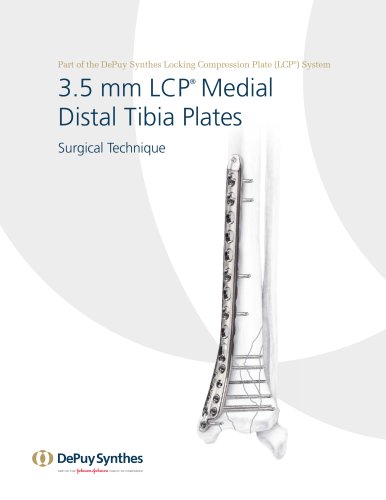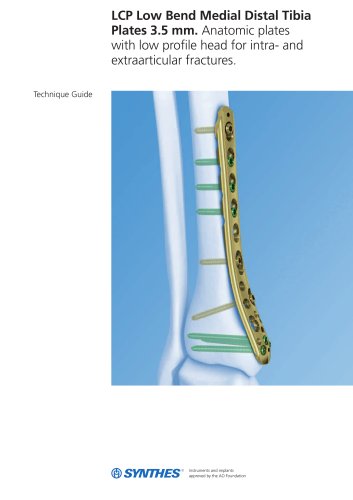 Website:
Depuy Synthes
Website:
Depuy Synthes
Group: Johnson & Johnson
Catalog excerpts
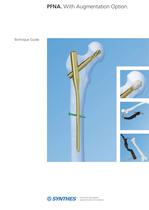
PFNA. With Augmentation Option. Technique Guide
Open the catalog to page 1
Introduction PFNA - System Overview 2 Surgical Technique Preoperative Planning 14 Option: PFNA Augmentation 45 Correction of Insertion Depth of PFNA Blade 76
Open the catalog to page 2
Product Information Augmentation Implants and Instruments Optional: Angular Stable Locking System (ASLS) 104 mage intensifier control This description alone does not provide sufficient background for direct use of the instrument set. Instruction by a surgeon experienced in handling these nstruments is highly recommended Reprocessing, Care and Maintenance of Synthes Instruments For general guidelines, function control and dismantling of multi-part instruments, please contact your local sales representative or refer to: PFNA. With Augmentation Option. Technique Guide Synthes 1
Open the catalog to page 3
PFNA. Proximal Femoral Nail PFNA Nail The anatomical design guarantees an optimal fit in the femur. The nail design has been well proven in over 450,000 cases performed with the PFN and PFNA. The PFNA has a medial-lateral angle of 6° This allows insertion at the tip of the greater Optimal stress distribution The flexible PFNA tip eases insertion and reduces stress on the bone at the tip of the Several distal locking options Static or dynamic locking can be per- formed via the aiming arm with PFNA standard, small and xs. The PFNA long additionally allows for secondary PFNA long 2 Synthes...
Open the catalog to page 4
PFNA Nail Product range The PFNA is available in 4 sizes PFNA small, length 200 mm PFNA long, length 300-420 mm, with 20 mm increments, bending PFNA. With Augmentation Option. Technique Guide Synthes 3
Open the catalog to page 5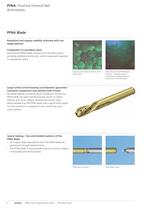
PFNA. Proximal Femoral Nail PFNA Blade Rotational and angular stability achieved with one single element Compaction of cancellous bone nserting the PFNA blade compacts the cancellous bone providing additional anchoring, which is especially important Bone structure before insertion of the Bone structure after PFNA blade PFNA blade. insertion - cancellous bone is compacted providing additional anchoring to the PFNA blade Large surface and increasing core diameter guarantee maximum compaction and optimal hold in bone ncreased stability caused by bone compaction around the PFNA blade has been...
Open the catalog to page 6
PFNA. Instrumentation. Easier guide wire positioning and insertion Correct positioning of the guide wire and finally the PFNA blade in the femoral head is crucial. The guide wire aiming device allows for AP orientation, which permits correction of the nail’s insertion depth prior to guide wire insertion. In the lateral view, rotation of the nail can be adjusted with the two orientation lines in the radiolucent insertion handle for PFNA. Intraoperative compression In good bone quality the new PFNA blades (0X.027.010S – 0X.027.021S and 0X.027.030S – 0X.027.041S) together with the compression...
Open the catalog to page 7
PFNA. Augmentation. Fractures of the hip are the most common operatively treated fractures of the elderly (over the age of 70). The number of osteoporotic fractures is growing dramatically causing treatment to become an increasingly challenging issue. The PFNA Augmentation offers a unique system of controlled cement augmentation directly through the implant: – Higher number of cycles to cut-out and increased rotational stability in biomechanical testing – Simple and reproducible procedure through standardized surgical technique – Compatible with PFNA instrumentation and implants –...
Open the catalog to page 8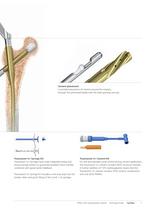
Cement placement Controlled placement of cement around the implant, through the perforated blade with the side-opening cannula. Traumacem V+ Syringe Kit Traumacem V+ Syringes have wide integrated wings and strong syringe pistons to guarantee excellent force transfer, combined with good tactile feedback. Traumacem V+ Syringe Kit includes a one-way stop-cock for simple, clean and quick filling of the 2 and 1 ml syringes. Traumacem V+ Cement Kit For the best possible visual control during cement application, the Traumacem V+ cement contains 40% zirconium dioxide. A further addition of 15%...
Open the catalog to page 9
8 Synthes PFNA. With Augmentation Option. Technique Guide
Open the catalog to page 10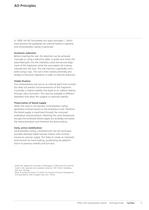
AO Principles In 1958, the AO formulated four basic principles1, 2, which have become the guidelines for internal fixation in general, and intramedullary nailing in particular: Anatomic reduction Before inserting the nail, the reduction can be achieved manually or using a reduction table. A guide wire marks the prescribed path into the medullary canal and secures alignment of the fragments while the cannulated nail is being inserted over the wire. The nail insertion is generally monitored using x-rays. The nail is then locked proximally and distally to the bone fragments in order to hold...
Open the catalog to page 11
Indications and Contraindications PFNA short (Length 170 mm – 240 mm) Indications – Pertrochanteric fractures (31-A1 and 31-A2) – Intertrochanteric fractures (31-A3) – High subtrochanteric fractures (32-A1) Contraindications – Low subtrochanteric fractures – Femoral shaft fractures – Isolated or combined medial femoral neck fractures PFNA long (Length 300 mm – 420 mm) Indications – Low and extended subtrochanteric fractures – Ipsilateral trochanteric fractures – Combination fractures (in the proximal femur) – Pathological fractures Contraindications – Isolated or combined medial femoral...
Open the catalog to page 12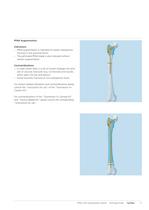
PFNA Augmentation Indications – PFNA augmentation is indicated for severe osteoporotic fractures in the proximal femur – The perforated PFNA blade is also indicated without cement augmentation Contraindications – In cases where there is a risk of cement leakage into articular or vascular structures (e.g. via fractures and injuries, which open into the articulation) – Acute traumatic fractures of non-osteoporotic bone For cement related indications and contraindications please consult the “instructions for use” of the “Traumacem V+ Cement Kit”. For contraindications of the “Traumacem V+...
Open the catalog to page 13
Clinical Cases PFNA 94 years, female 31-A1.1 0 days post-op 14 weeks post-op 11 months post-op 93 years, female, 31-A3.3 4 days post-op 4 weeks post-op 5 months post-op 12 Synthes PFNA. With Augmentation Option. Technique Guide
Open the catalog to page 14All Depuy Synthes catalogs and technical brochures
-
ZERO-P NATURAL™PLATE
5 Pages
-
2.0 mm LCP® Distal Ulna Plate
20 Pages
-
SYNFLATE SYSTEM
3 Pages
-
2.4 mm VA LCP™
4 Pages
-
Building on Success
16 Pages
-
HEALIX ADVANCE
4 Pages
-
RADIUS OF CURVATURE
3 Pages
-
Introducing The Variable Angle
12 Pages
-
HEALIX Anchor™ 3.4 mm
2 Pages
-
Small Battery Drive II
4 Pages
-
HEALIX ADVANCE
4 Pages
-
3.5 mm LCP™ Medial
15 Pages
-
Titanium Sternal Fixation System
34 Pages
-
MatrixRIB®FixationSystem
86 Pages
-
Mandible Trauma Solutions
2 Pages
-
Power line II
4 Pages
-
Concorde
28 Pages
-
LCP Intercarpal
31 Pages
-
LCS® COMPLETE™
2 Pages
-
Synthes TPLO.
8 Pages
-
SynFix-LR System
56 Pages
-
ATB Anterior Tension Band Plate
32 Pages
-
CONDUIT™
15 Pages
-
Brochure_FINAL
2 Pages
-
DePuy Synthes
81 Pages
-
Anspach
3 Pages
-
Orthopedic Foot Instruments
32 Pages
-
PINNACLE® Hip Solutions
12 Pages
-
Corail
24 Pages
-
S-ROM® NOILES™
68 Pages
-
TRI-LOCK® Product Rationale
12 Pages
-
Reclaim Surgical Technique
44 Pages
-
Speed
2 Pages
-
attune
80 Pages
-
HAMMERLOCK® 2
2 Pages
-
DePuy Glenoid Solutions
2 Pages
-
Trauma Solutions. Elbow
4 Pages
-
Polar
4 Pages
-
Alveolar Distractor.
4 Pages
-
Piezoelectric System
4 Pages
-
Air Power Line II
6 Pages
-
LCP Clavicle Hook Plate
4 Pages
-
TruMatch Pin Guides
16 Pages
-
P F N A
8 Pages
-
SKILL, DEDICATION,
16 Pages
-
Orthopaedics. Overview
20 Pages
-
DURALOC
16 Pages
-
Marathon Cemented Cup
20 Pages
-
REEF Surgical Technique
16 Pages
-
MatrixNEURO
8 Pages
-
Anspach XMax
4 Pages
-
Anspach eMax 2 Plus
4 Pages
-
Small Electric Drive
4 Pages
-
Air Pen Drive
4 Pages
-
Colibri II
4 Pages
-
Spine
25 Pages
-
Expert Hindfoot Arthrodesis Nail
48 Pages
-
LCP Distal Fibula Plates
32 Pages
-
TomoFix
60 Pages
-
Expert Tibial Nail PROtect
16 Pages
-
Expert Tibia Nail
84 Pages
-
Sacral Bars
16 Pages
-
Pelvic C-Clamp
20 Pages
-
Low Profile Pelvic System
16 Pages
-
Proximal Femoral (Hook) Plate
24 Pages
-
LCP
24 Pages
-
HCS 1.5, 2.4, 3.0
36 Pages
-
LCP Wrist Fusion
32 Pages
-
LCP Compact Hand
28 Pages
-
VA-LCP Elbow
48 Pages
-
Distal Radius
44 Pages
-
Olecranon
30 Pages
-
LCP Hook Plate
28 Pages
-
DHP & Olecranon
4 Pages
-
LCP S-A
4 Pages
-
Epoca
4 Pages
-
Philos
32 Pages
-
MultiLoc
68 Pages














